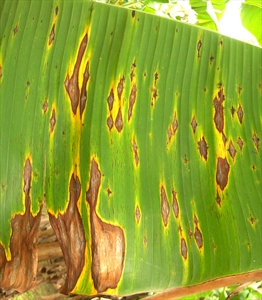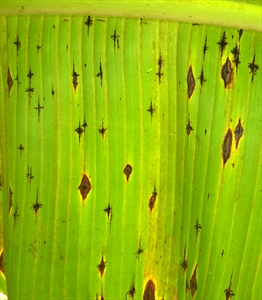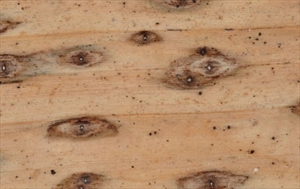Banana (Cordana) leaf spot, banana diamond leaf spot
Pacific Pests, Pathogens and Weeds - Online edition
Pacific Pests, Pathogens & Weeds
Banana diamond leaf spot (072)
Cordana musae
Asia, Africa (restricted), Oceania. It is recorded from Australia, American Samoa, Cook Islands, Federated States of Micronesia, Fiji, French Polynesia, Marshall Islands, New Caledonia, Niue, Palau, Papua New Guinea, Samoa, Solomon Islands, Tonga, Vanuatu, and Wallis & Futuna.
Musa spp., and also Musa acuminata subsp. banksii (Samoa).
The spots are oval to diamond-shaped, up to 10 cm long, and at right angles to the length of the leaf (Photo 1). They are brown on the upper surface, zoned, with yellow margins, and grey to brown below. The spots often merge, covering large areas of the leaf; this occurs particularly at the margin of the leaf giving a band of dead tissue with a zigzag yellow border between diseased and healthy parts.
Banana (Cordana) leaf spot infections often occurs on banana black cross leaf spots (Photos 2&3, and see Fact Sheet no. 71). This suggests that the fungus is a weak pathogen and needs a wound to infect.
Spores are produced on the underside of the leaf in large numbers, making the spots appear greyish-brown and hairy. They are spread in wet, windy weather.
Another species, Cordana johnsonii, occurs in Australia and Tonga (Photo 4).
Usually, the disease is of minor importance on Cavendish bananas, but can sometimes be severe on plantains, that is, cooking bananas, but it is not likely to reduce yields to the extent that control measures are required. This disease is said to be worse if misting oils are used. Misting oils are used for the control of black Sigatoka (see Fact Sheet no. 02).
Look for the diamond-shaped brown spots, with a yellow border, often common along the margin of the leaf. Look to see if the spots are centred on the star-shaped spots of Phyllachora.
CULTURAL CONTROL
Control measures are unlikely to be needed against this disease.
RESISTANT VARIETIES
Cavendish varieties are resistant. The fungus usually infects cooking bananas, but the damage is usually insignificant. There is no information on the resistance of the FHIA varieties bred in Honduras, Central America, and imported by the Secretariat of the Pacific Community (CePaCT lab) for distribution in the region.
CHEMICAL CONTROL
The disease is of minor importance in commercial varieties and, even in those that are susceptible, it is not thought to lower yield sufficiently to need control by fungicides.
AUTHORS Helen Tsatsia & Grahame Jackson
Information from McKenzie E (2013) Cordana musae: PaDIL - http://www.padil.gov.au; and (including Photo 4) McKenzie E (2013) Cordana johnsonii: PaDIL - (http://www.padil.gov.au); and Vézina A, Dreyer BS (2020) Cordana leaf spot. ProMusa. (https://www.promusa.org/Cordana+leaf+spot).
Produced with support from the Australian Centre for International Agricultural Research under project PC/2010/090: Strengthening integrated crop management research in the Pacific Islands in support of sustainable intensification of high-value crop production, implemented by the University of Queensland and the Secretariat of the Pacific Community.







